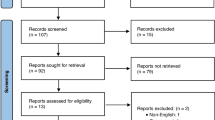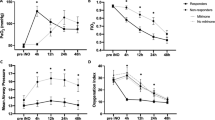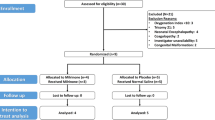Abstract
Recent advances in our understanding of neonatal pulmonary circulation and the underlying pathophysiology of hypoxemic respiratory failure (HRF)/persistent pulmonary hypertension of the newborn (PPHN) have resulted in more effective management strategies. Results from animal studies demonstrate that low alveolar oxygen tension (PAO2) causes hypoxic pulmonary vasoconstriction, whereas an increase in oxygen tension to normoxic levels (preductal arterial partial pressure of oxygen (PaO2) between 60 and 80 mm Hg and/or preductal peripheral capillary oxygen saturation between 90% and 97%) results in effective pulmonary vasodilation. Hyperoxia (preductal PaO2 >80 mm Hg) does not cause further pulmonary vasodilation, and oxygen toxicity may occur when high concentrations of inspired oxygen are used. It is therefore important to avoid both hypoxemia and hyperoxemia in the management of PPHN. In addition to oxygen supplementation, therapeutic strategies used to manage HRF/PPHN in term and late preterm neonates may include lung recruitment with optimal mean airway pressure and surfactant, inhaled and intravenous vasodilators and ‘inodilators’. Clinical evidence suggests that administration of surfactant or inhaled nitric oxide (iNO) therapy at a lower acuity of illness can decrease the risk of extracorporeal membrane oxygenation/death, progression of HRF and duration of hospital stay. Milrinone may be beneficial as an inodilator and may have specific benefits following prolonged exposure to iNO plus oxygen owing to inhibition of phosphodiesterase (PDE)-3A. Additionally, sildenafil, and, in selected cases, hydrocortisone may be appropriate options after hyperoxia and oxidative stress owing to their effects on PDE-5 activity and expression. Continued investigation into these and other interventions is needed to optimize treatment and improve outcomes.
This is a preview of subscription content, access via your institution
Access options





Similar content being viewed by others
References
Clark RH . The epidemiology of respiratory failure in neonates born at an estimated gestational age of 34 weeks or more. J Perinatol 2005; 25: 251–257.
Walsh-Sukys MC, Tyson JE, Wright LL, Bauer CR, Korones SB, Stevenson DK et al. Persistent pulmonary hypertension of the newborn in the era before nitric oxide: practice variation and outcomes. Pediatrics 2000; 105: 14–20.
Konduri GG, Kim UO . Advances in the diagnosis and management of persistent pulmonary hypertension of the newborn. Pediatr Clin North Am 2009; 56: 579–600.
Nair J, Lakshminrusimha S . Update on PPHN: mechanisms and treatment. Semin Perinatol 2014; 38: 78–91.
Steinhorn RH . Diagnosis and treatment of pulmonary hypertension in infancy. Early Hum Dev 2013; 89: 865–874.
Lakshminrusimha S, Russell JA, Steinhorn RH, Swartz DD, Ryan RM, Gugino SF et al. Pulmonary hemodynamics in neonatal lambs resuscitated with 21%, 50%, and 100% oxygen. Pediatr Res 2007; 62: 313–318.
Lakshminrusimha S, Swartz DD, Gugino SF, Ma CX, Wynn KA, Ryan RM et al. Oxygen concentration and pulmonary hemodynamics in newborn lambs with pulmonary hypertension. Pediatr Res 2009; 66: 539–544.
Lakshminrusimha S, Steinhorn RH, Wedgwood S, Savorgnan F, Nair J, Mathew B et al. Pulmonary hemodynamics and vascular reactivity in asphyxiated term lambs resuscitated with 21 and 100% oxygen. J Appl Physiol (1985) 2011; 111: 1441–1447.
Perlman JM, Wyllie J, Kattwinkel J, Atkins DL, Chameides L, Goldsmith JP et al. Part 11: Neonatal resuscitation: 2010 International Consensus on Cardiopulmonary Resuscitation and Emergency Cardiovascular Care Science With Treatment Recommendations. Circulation 2010; 122: S516–S538.
Kattwinkel J, Perlman JM, Aziz K, Colby C, Fairchild K, Gallagher J et al. Part 15: Neonatal resuscitation: 2010 American Heart Association Guidelines for Cardiopulmonary Resuscitation and Emergency Cardiovascular Care. Circulation 2010; 122: S909–S919.
Moudgil R, Michelakis ED, Archer SL . Hypoxic pulmonary vasoconstriction. J Appl Physiol (1985) 2005; 98: 390–403.
Rudolph AM, Yuan S . Response of the pulmonary vasculature to hypoxia and H+ ion concentration changes. J Clin Invest 1966; 45: 399–411.
Sanderud J, Norstein J, Saugstad OD . Reactive oxygen metabolites produce pulmonary vasoconstriction in young pigs. Pediatr Res 1991; 29: 543–547.
Sanderud J, Bjoro K, Saugstad OD . Oxygen radicals stimulate thromboxane and prostacyclin synthesis and induce vasoconstriction in pig lungs. Scand J Clin Lab Invest 1993; 53: 447–455.
Lakshminrusimha S, Russell JA, Wedgwood S, Gugino SF, Kazzaz JA, Davis JM et al. Superoxide dismutase improves oxygenation and reduces oxidation in neonatal pulmonary hypertension. Am J Respir Crit Care Med 2006; 174: 1370–1377.
Belik J, Jankov RP, Pan J, Yi M, Chaudhry I, Tanswell AK . Chronic O2 exposure in the newborn rat results in decreased pulmonary arterial nitric oxide release and altered smooth muscle response to isoprostane. J Appl Physiol (1985) 2004; 96: 725–730.
Faraci FM, Didion SP . Vascular protection: superoxide dismutase isoforms in the vessel wall. Arterioscler Thromb Vasc Biol 2004; 24: 1367–1373.
Lakshminrusimha S, Russell JA, Steinhorn RH, Ryan RM, Gugino SF, Morin FC III et al. Pulmonary arterial contractility in neonatal lambs increases with 100% oxygen resuscitation. Pediatr Res 2006; 59: 137–141.
Farrow KN, Groh BS, Schumacker PT, Lakshminrusimha S, Czech L, Gugino SF et al. Hyperoxia increases phosphodiesterase 5 expression and activity in ovine fetal pulmonary artery smooth muscle cells. Circ Res 2008; 102: 226–233.
Sanderud J, Oroszlan G, Bjoro K, Kumlin M, Saugstad OD . D-penicillamine inhibits the action of reactive oxygen species in the pig pulmonary circulation. J Perinat Med 1995; 23: 385–393.
Steinhorn RH, Albert G, Swartz DD, Russell JA, Levine CR, Davis JM . Recombinant human superoxide dismutase enhances the effect of inhaled nitric oxide in persistent pulmonary hypertension. Am J Respir Crit Care Med 2001; 164: 834–839.
Afolayan AJ, Teng RJ, Eis A, Mickalkiewicz T, Konduri GG. Decreased nitric oxide (NO) levels contribute to impaired mitochondrial biogenesis and oxidative stress in fetal lambs with persistent pulmonary hypertension (PPHN). Abstract presented at the Pediatric Academic Societies (PAS) Annual Meeting; 26 April 2015; San Diego, CA, USA. Abstract 2785.2.
Afolayan AJ, Eis A, Alexander M, Michalkiewicz T, Teng RJ, Lakshminrusimha S et al. Decreased endothelial NOS expression and function contributes to impaired mitochondrial biogenesis and oxidative stress in fetal lambs with PPHN. Am J Physiol Lung Cell Mol Physiol 2015; 310 (1): L40–L49.
Roberts JD Jr., Fineman JR, Morin FC III, Shaul PW, Rimar S, Schreiber MD et al. Inhaled nitric oxide and persistent pulmonary hypertension of the newborn. The Inhaled Nitric Oxide Study Group. N Engl J Med 1997; 336: 605–610.
Inhaled nitric oxide and hypoxic respiratory failure in infants with congenital diaphragmatic hernia. The Neonatal Inhaled Nitric Oxide Study Group (NINOS). Pediatrics 1997; 99: 838–845.
Clark RH, Kueser TJ, Walker MW, Southgate WM, Huckaby JL, Perez JA et al. Low-dose nitric oxide therapy for persistent pulmonary hypertension of the newborn. Clinical Inhaled Nitric Oxide Research Group. N Engl J Med 2000; 342: 469–474.
Early compared with delayed inhaled nitric oxide in moderately hypoxaemic neonates with respiratory failure: a randomised controlled trial. The Franco-Belgium Collaborative NO Trial Group. Lancet 1999; 354: 1066–1071.
Gonzalez A, Fabres J, D'Apremont I, Urcelay G, Avaca M, Gandolfi C et al. Randomized controlled trial of early compared with delayed use of inhaled nitric oxide in newborns with a moderate respiratory failure and pulmonary hypertension. J Perinatol 2010; 30: 420–424.
Konduri GG, Solimano A, Sokol GM, Singer J, Ehrenkranz RA, Singhal N et al. A randomized trial of early versus standard inhaled nitric oxide therapy in term and near-term newborn infants with hypoxic respiratory failure. Pediatrics 2004; 113: 559–564.
Konduri GG, Sokol GM, Van Meurs KP, Singer J, Ambalavanan N, Lee T et al. Impact of early surfactant and inhaled nitric oxide therapies on outcomes in term/late preterm neonates with moderate hypoxic respiratory failure. J Perinatol 2013; 33: 944–949.
Konduri GG, Menzin J, Frean M, Lee T, Potenziano J, Singer J . Inhaled nitric oxide in term/late preterm neonates with hypoxic respiratory failure: estimating the financial impact of earlier use. J Med Econ 2015; e-pub ahead of print.
Findlay RD, Taeusch HW, Walther FJ . Surfactant replacement therapy for meconium aspiration syndrome. Pediatrics 1996; 97: 48–52.
Lotze A, Mitchell BR, Bulas DI, Zola EM, Shalwitz RA, Gunkel JH . Multicenter study of surfactant (beractant) use in the treatment of term infants with severe respiratory failure. Survanta in Term Infants Study Group. J Pediatr 1998; 132: 40–47.
Kelly LK, Porta NF, Goodman DM, Carroll CL, Steinhorn RH . Inhaled prostacyclin for term infants with persistent pulmonary hypertension refractory to inhaled nitric oxide. J Pediatr 2002; 141: 830–832.
Ehlen M, Wiebe B . Iloprost in persistent pulmonary hypertension of the newborn. Cardiol Young 2003; 13: 361–363.
Kahveci H, Yilmaz O, Avsar UZ, Ciftel M, Kilic O, Laloglu F et al. Oral sildenafil and inhaled iloprost in the treatment of pulmonary hypertension of the newborn. Pediatr Pulmonol 2014; 49: 1205–1213.
Lakshminrusimha S . The pulmonary circulation in neonatal respiratory failure. Clin Perinatol 2012; 39: 655–683.
Kirmani KI, Ryan RM, Morin FC et al Effect of dopamine on pulmonary and systemic pressures in control and PPHN neonatal lambs. Abstract presented at the Pediatric Academic Societies (PAS) Meeting; 38 May 2007; Toronto, ON, Canada. Abstract 6291.20.
Rashid N, Morin FC III, Swartz DD, Ryan RM, Wynn KA, Wang H et al. Effects of prostacyclin and milrinone on pulmonary hemodynamics in newborn lambs with persistent pulmonary hypertension induced by ductal ligation. Pediatr Res 2006; 60: 624–629.
Busch CJ, Graveline AR, Jiramongkolchai K, Liu H, Sanchez LS, Bloch KD . Phosphodiesterase 3A expression is modulated by nitric oxide in rat pulmonary artery smooth muscle cells. J Physiol Pharmacol 2010; 61: 663–669.
Chen B, Lakshminrusimha S, Czech L, Groh BS, Gugino SF, Russell JA et al. Regulation of phosphodiesterase 3 in the pulmonary arteries during the perinatal period in sheep. Pediatr Res 2009; 66: 682–687.
Bassler D, Choong K, McNamara P, Kirpalani H . Neonatal persistent pulmonary hypertension treated with milrinone: four case reports. Biol Neonate 2006; 89: 1–5.
McNamara PJ, Laique F, Muang-In S, Whyte HE . Milrinone improves oxygenation in neonates with severe persistent pulmonary hypertension of the newborn. J Crit Care 2006; 21: 217–222.
Baquero H, Soliz A, Neira F, Venegas ME, Sola A . Oral sildenafil in infants with persistent pulmonary hypertension of the newborn: a pilot randomized blinded study. Pediatrics 2006; 117: 1077–1083.
Steinhorn RH, Kinsella JP, Pierce C, Butrous G, Dilleen M, Oakes M et al. Intravenous sildenafil in the treatment of neonates with persistent pulmonary hypertension. J Pediatr 2009; 155: 841–847.
Farrow KN, Steinhorn RH . Sildenafil therapy for bronchopulmonary dysplasia: not quite yet. J Perinatol 2012; 32: 1–3.
Mourani PM, Sontag MK, Ivy DD, Abman SH . Effects of long-term sildenafil treatment for pulmonary hypertension in infants with chronic lung disease. J Pediatr 2009; 154: 379–384.
Clinicaltrials.gov Web site. A study to evaluate safety and efficacy of IV sildenafil in the treatment of neonates with persistent pulmonary hypertension of the newborn. www.clinicaltrials.gov 2015.
Mohamed WA, Ismail M . A randomized, double-blind, placebo-controlled, prospective study of bosentan for the treatment of persistent pulmonary hypertension of the newborn. J Perinatol 2012; 32: 608–613.
Steinhorn RH, Kusic-Pajic A, Cornelisse P, Fineman JR, Gehin M, Nowbakht P et al. Bosentan as adjunctive therapy for persistent pulmonary hypertension of the newborn: Results of the FUTURE-4 Study. Circulation 2014; 130: A13503.
Tripathi S, Saili A . The effect of steroids on the clinical course and outcome of neonates with meconium aspiration syndrome. J Trop Pediatr 2007; 53: 8–12.
Perez M, Lakshminrusimha S, Wedgwood S, Czech L, Gugino SF, Russell JA et al. Hydrocortisone normalizes oxygenation and cGMP regulation in lambs with persistent pulmonary hypertension of the newborn. Am J Physiol Lung Cell Mol Physiol 2012; 302: L595–L603.
Mokra D, Mokry J . Glucocorticoids in the treatment of neonatal meconium aspiration syndrome. Eur J Pediatr 2011; 170: 1495–1505.
Teng RJ, Du J, Afolayan AJ, Eis A, Shi Y, Konduri GG . AMP kinase activation improves angiogenesis in pulmonary artery endothelial cells with in utero pulmonary hypertension. Am J Physiol Lung Cell Mol Physiol 2013; 304: L29–L42.
Armitage P . Sequential Medical Trials. 2nd edn. John Wiley & Sons: New York, USA, 1975.
Acknowledgements
This work is based on discussions at a roundtable meeting supported by a grant from Mallinckrodt Pharmaceuticals, formerly Ikaria. Presentations and discussions were developed solely by the participants, without grantor input. The meeting chair (RHS) determined the agenda and attendees. SL, GGK and RHS developed the presentations and led the discussions upon which this article is based, provided critical review and revisions to the outline and manuscript drafts, provided final approval of the version to be published and are accountable for the integrity of the content and for addressing questions. We thank the contributions of the following individuals who participated in discussion that shaped the content of this article: Namasivayam Ambalavanan, MD, Judy L Aschner, MD, Jason Gien, MD, John Kinsella, MD and Ola Didrik Saugstad, MD, PhD, FRCPE. Writing and editorial assistance was provided by John Kross, and Sharon Suntag and Julie Gerke of Quintiles.
Author information
Authors and Affiliations
Corresponding author
Ethics declarations
Competing interests
SL, GGK and RHS received honoraria for their participation in a roundtable meeting supported by a grant from Mallinckrodt Pharmaceuticals, formerly Ikaria. SL was a member of the speaker’s bureau for Ikaria from June 2010 to October 2014 and has received grant support from the American Academy of Pediatrics and Canadian Pediatric Society. GGK has received consulting fees from Boston Health Economics and Actelion Clinical Research and lecture fees from Quintiles. RHS has received research grant support from Pfizer. NIH Grants: 5R01HD072929-03 (to SL); 5R01HL057268-11 (to GGK); 5R01HL054705-13 (to RHS).
Rights and permissions
About this article
Cite this article
Lakshminrusimha, S., Konduri, G. & Steinhorn, R. Considerations in the management of hypoxemic respiratory failure and persistent pulmonary hypertension in term and late preterm neonates. J Perinatol 36 (Suppl 2), S12–S19 (2016). https://doi.org/10.1038/jp.2016.44
Received:
Revised:
Accepted:
Published:
Issue date:
DOI: https://doi.org/10.1038/jp.2016.44
This article is cited by
-
Meconium aspiration syndrome: a comprehensive review
Journal of Perinatology (2023)
-
Care of the critically ill neonate with hypoxemic respiratory failure and acute pulmonary hypertension: framework for practice based on consensus opinion of neonatal hemodynamics working group
Journal of Perinatology (2022)
-
Hemodynamic response to milrinone for refractory hypoxemia during therapeutic hypothermia for neonatal hypoxic ischemic encephalopathy
Journal of Perinatology (2021)
-
Change in neonatal resuscitation guidelines and trends in incidence of meconium aspiration syndrome in California
Journal of Perinatology (2020)
-
Intravenous epoprostenol improves oxygenation index in patients with persistent pulmonary hypertension of the newborn refractory to nitric oxide
Journal of Perinatology (2018)



